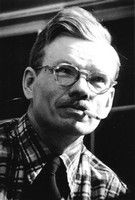Kenneth Stubbs |
 |
|
Stubbs' formula for success had many stylesArtist Kenneth Stubbs always took his own course. That led him down some unexpected artistic roads, and when he died in 1967 he left a body of work that encompassed everyting from deft drawings and renderings done in the style of the masters to thoroughly modern abstract works. A retrospective of his art is the subject of an exhibition at the Fine Arts Work Center, 24 Pearl St., beginning with a reception from 6 to 8 p.m. on Friday and running through Aug. 8. Born in the small Georgia town of Ochlocknee, Stubbs showed himself early on to be the family's first artist by creating a series of figures from the omnipresent red Georgia clay. His interest never abated after that. Stubbs' family moved to the Washington, D.C. area and he attended the Corcoran School of Art, graduating in 1930. Work took him to Detroit where he was fortunate to get an advertising job. One of his duties there was painting billboards, not his favorite thing since he didn't like heights. During those years of work in Detroit, he also began coming to Provincetown where he opted to study with the modernist Ambrose Webster instead of the traditionalist Charles Hawthorne. The two years he spent with Webster gave a strong direction to much of his future work, a direction that he honed himself. In 1935 he began to teach at the Corcoran and remained there until 1953, though that was interrupted by a stint in the Navy from '42-'45. The Navy taught him to make training films from the highly technical to the simplistic like "Swab Your Choppers," a film to teach farm boys how to brush their teeth. That film work later expanded into work for private industry. All the while, he continued to paint the things he loved. His work took more than one simultaneous direction and while he painted in increasingly abstract, and eventually cubist ways, his drawings and watercolors remainted true to nature. The end results are "solid pattern" paintings that, although abstract in nature, are filled with mathematical precision and forceful color work, and watercolors diffused with motion that fairly glow with interior light. His wife, Miriam, still maintains the family home on Bradford Street that they bought from Mischa Richter. During summers she returns, and often their two children, now grown with their own families, spend time in town as well. Miriam talked with the Banner about her husband and his work. Right after their marriage in 1948, they took off for Europe where they managed to parlay two months workth of Fulbright money into eight months of travel. Miriam gave her husband a 16 mm camera for a wedding present and he used it to film Piero della Francesco's mural of "The Golden Legend," in Arezzo, Italy. She still has the film. While in France, they heard of the recently discovered caves of Lascaux with their amazing prehistoric paintings. They went. "There were no guards, no signs, nothing," she recalls. "We went in and saw the paintings and when we came out, I said, 'Kenneth, look, this is what they used.' On the ground was charcoal and the red earth. There was just such a feeling of awe when you think that someone did that." (The caves have since been closed to the public, but replicas are open.) When asked what makes her husband's work stand out, Miriam replies, "The beauty of the form, the color and the motion. Motion is the surprise there. When you look [at "Pearl Street"], it's not just still, you are going up that street." His cubist work, she says, takes that genre even further by the addition of motion; she describes an abstract painting she used to keep in her bedroom and says she could "walk around" inside. As for the watercolors, she notes, "It's very demanding. That water will go where it will on the paper and you can't correct it like oils. The watercolorist must always anticipate what is being left blank." She talks about his lifelong chess enthusiasm and says, "When you go to a new town, it's like joining a church, you find the other chess people." Miriam pulls out memories like colored beads and strings them in the air, remembering how private her husband was about his painting time and studio, about his steady temperament that was rarely shaken. "I only saw him lose his temper twice, once when the rain fell on his watercolor at Positano," she said. "He could curse a blue streak but in a genteel way." His strongest qualities were his goodness and his integrity, she says as she heaps praise on both his person and his work. "This is from a wife still in love with the husband she lost 30-some years ago," she says. "That is a hard act to follow." Sue Harrison, Provincetown Banner, July 20, 2000, page 38
|
See also: Show Announcement Web Announcement Show Catalog Curator's Statement Works Shown Art New England Review |